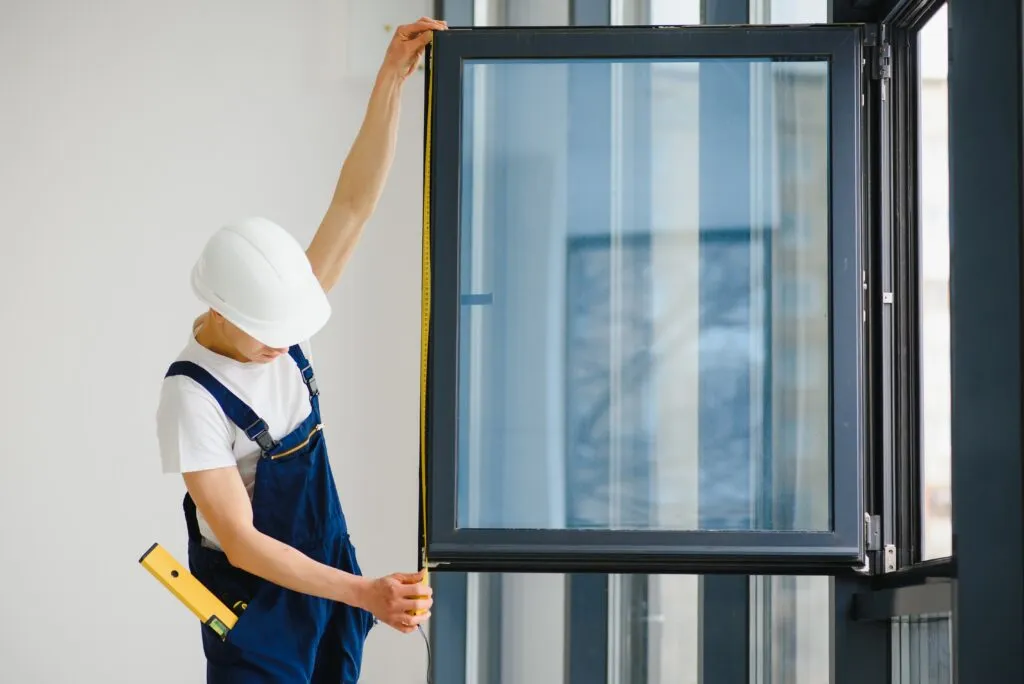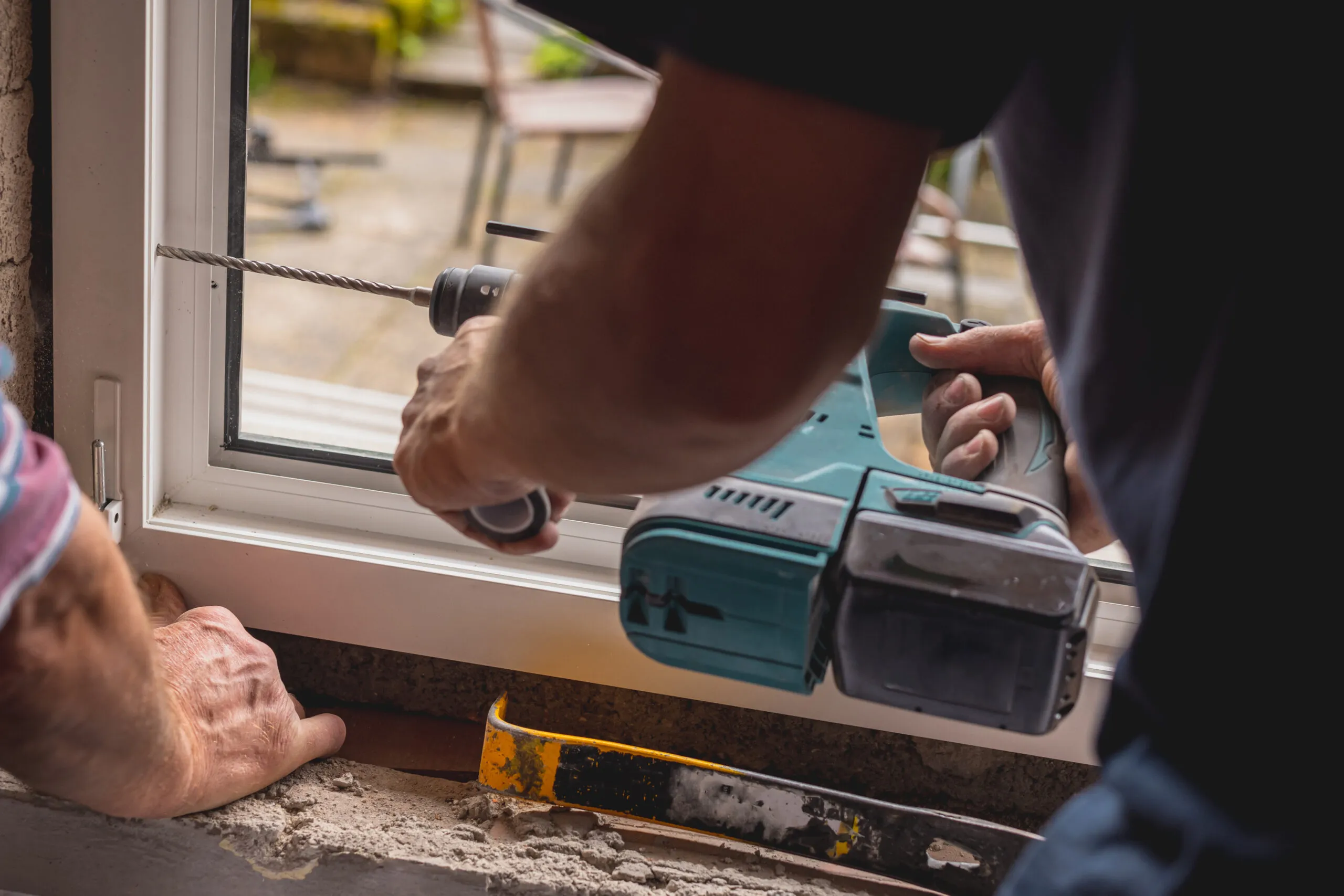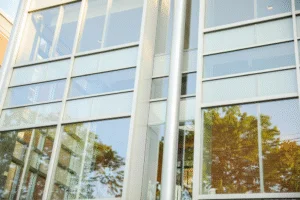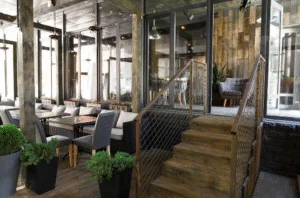
Hiring an inexperienced installer may seem like a cost-saving decision, but it can lead to significant window and door installation challenges.
Many installation issues stem from poor material selection, incorrect measurements, and lack of expertise. Improper sealing can cause air leaks, leading to higher energy bills, while poorly fitted frames can result in moisture buildup, mold, and compromised security. Even minor alignment errors can affect the durability of windows and doors.
However, these challenges are avoidable. Understanding and early addressing these issues will save you time, money, and frustration.
This guide explores the most common window and door installation challenges and provides practical solutions to ensure a seamless, efficient, and high-quality installation. Check it out!
Incorrect measurements and improvised adjustments: Window and door installation challenges
Window and door installation challenges begin with something as simple, but critical, as measurement errors. Even a few millimeters off can lead to misaligned frames, gaps, and poor sealing, compromising functionality and aesthetics.
When measurements are inaccurate, installers resort to on-the-spot adjustments, which may include forced fittings, excessive caulking, or trimming frames to make them fit.
These “quick fixes” result in poor insulation, structural instability, and early wear and tear. In the worst cases, an improperly sized window or door may need to be entirely replaced.
Focus on precision from the start to avoid window and door installation challenges
Use professional-grade measurement tools
A basic tape measure isn’t always enough. Tools like laser measuring devices and digital calipers provide higher accuracy, reducing the risk of miscalculations.
Follow a standardized measurement process
Always measure width, height, and depth at multiple points to account for irregular wall surfaces. Double-checking measurements before ordering materials can prevent costly mistakes.
Work with experienced professionals
Expert installers understand the nuances of measuring for different frame types and building materials. Hiring experts ensures proper fitting and alignment, eliminating the need for last-minute modifications.
Account for expansion and contraction
Depending on the climate, materials like wood and aluminum expand or contract. Factoring in seasonal changes helps prevent future warping or gaps.
Prioritizing accurate measurements from the beginning is key to avoid window and door installation challenges, improve energy efficiency, and ensure a seamless installation.
In the next section, we’ll discuss another common issue: choosing the wrong materials and how it can affect your installation’s longevity.
Choosing the wrong materials: Window and door installation challenges
Selecting the right materials is just as important as the installation process itself. Yet, choosing low-quality or unsuitable materials is one of the most common window and door installation challenges.
An aesthetically pleasing window or door can deteriorate if environmental factors are ignored.
For example, wood frames in humid climates can swell and rot, while cheap vinyl doors may crack under extreme temperature changes. Similarly, using single-pane glass in cold regions leads to heat loss and condensation buildup, affecting comfort and energy efficiency.
Consider the pros and cons of each material
Wood
| PROS | CONS |
| Timeless, high-end appearance that enhances property value. | Prone to warping, swelling, and rotting in humid climates. |
| Natural insulator, providing excellent thermal efficiency. | Requires regular sealing, painting, or staining to maintain durability. |
| Can be painted or stained for custom finishes. | More expensive than other materials. |
Aluminum
| PROS | CONS |
| Lightweight yet strong, resistant to corrosion and extreme weather conditions. | Conducts heat, making it less energy-efficient unless thermally broken. |
| Ideal for modern architectural designs with slim, sleek frames. | Can develop condensation issues in cold climates. |
| Requires minimal maintenance compared to wood. |
Vinyl (PVC)
| PROS | CONS |
| Low maintenance, resistant to moisture and rot. | Can become brittle in freezing temperatures or discolored in prolonged sun exposure. |
| Good insulation properties, reducing energy costs. | Fewer customization options compared to wood. |
| Affordable compared to wood and fiberglass. |
Fiberglass
| PROS | CONS |
| One of the most durable materials available. | Higher initial cost compared to vinyl. |
| High thermal efficiency, reducing heat transfer. | Limited color options unless factory-painted. |
| Can mimic the look of wood without high maintenance. |
Composite
| PROS | CONS |
| Combines wood fibers and polymers, offering durability and insulation. | More expensive than vinyl, but less customizable than wood. |
| Resistant to moisture, warping, and decay. | |
| Provides better energy efficiency than aluminum. |
Steel
| PROS | CONS |
| Highly secure and durable, resistant to warping and extreme weather. | Conducts temperature, making it less energy-efficient unless insulated. |
| Offers a sleek, industrial look for modern designs. | Can be susceptible to rust if not properly treated. |
Choose materials that match your environment and needs
Consider climate and exposure
Different materials react differently to heat, moisture, and temperature fluctuations. Aluminum is excellent for humid conditions, while composite and fiberglass perform well in extreme climates.
Invest in energy-efficient glass
Double or triple-pane glass with Low-E coatings improves insulation, reducing energy bills and preventing condensation.
Check for durability and maintenance requirements
Materials like fiberglass and high-quality vinyl require minimal upkeep, while wood needs regular treatment to prevent warping and decay.
Verify material certifications
Look for materials that meet Energy Star or LEED standards to ensure long-term performance and sustainability.
Choosing the right materials from the start helps avoid premature replacements, improves energy efficiency, and enhances overall building integrity.
Next, we’ll discuss another major challenge: how improper installation can lead to structural issues and costly repairs.
Unprofessional Installation: Window and door installation challenges
Hiring unqualified teams to perform the installation is one of the most critical window and door installation challenges.
Poor workmanship can lead to issues that compromise efficiency, durability, and aesthetics. Without the right expertise, problems such as improper sealing, misalignment, and product damage can lead to costly repairs and reduced longevity.
Some common issues with poor installation are:
- Improper sealing
- Misalignment
- Product damage
It is crucial to work with reputable professionals who guarantee high-quality workmanship to avoid these window and door installation challenges.
Why hiring experienced installers makes a difference
Expertise and precision
Certified installers follow industry best practices, ensuring windows and doors are properly fitted and aligned.
Quality sealing and insulation
Professional teams use high-grade sealants and insulation materials, reducing energy loss and preventing water infiltration.
Manufacturer compliance
Many window and door manufacturers require certified installation to uphold warranty terms. Working with a professional ensures compliance with product guidelines.
Long-term reliability
A properly installed window or door reduces the need for frequent maintenance and costly repairs.
Ensuring a flawless installation process
To guarantee a smooth installation, follow these steps:
Verify credentials
Ensure the installation team is licensed, insured, and has experience handling the specific products being installed.
Check reviews and references
Research customer reviews and ask for referrals to confirm the installer’s reputation.
Request a warranty
Reputable companies offer warranties on their installation services, providing safety against future defects.
Businesses and homeowners can prevent unnecessary window and door installation challenges by choosing a trusted provider, ensuring a seamless and durable result.
Sustainable materials for eco-friendly windows and doors

As green building practices become the industry standard, selecting the right materials is essential for maximizing sustainability, durability, and performance.
Eco-friendly windows and doors contribute to energy conservation, resource efficiency, and long-term cost savings. Below, we explore the best sustainable materials for windows and doors, their benefits, and how they align with green building standards.
Recycled aluminum
Aluminum is one of the most recyclable materials in construction, with its original material being reusable without losing quality.
Unlike traditional aluminum, which requires high energy consumption for production, recycled aluminum reduces carbon emissions and supports circular economy practices.
Why choose recycled aluminum?
- Resistant to corrosion, guaranteeing long-term performance.
- When paired with thermally broken frames, it enhances insulation and reduces heat transfer.
- Requires 95% less energy to produce compared to primary aluminum.
FSC-Certified Wood
Wood is a biodegradable and renewable resource, but not all wood is sustainable. FSC-certified wood (Forest Stewardship Council) ensures the material comes from responsibly managed forests with minimal environmental impact.
Why choose FSC-certified wood?
- Provides excellent thermal efficiency, reducing heating and cooling needs.
- Unlike synthetic materials, wood stores carbon rather than emitting it.
- Combines sustainability with warm and natural design aesthetics.
Recycled PVC or Eco-friendly PVC
Traditional PVC (polyvinyl chloride) is criticized for its environmental impact, but recent advancements have introduced low-impact and recycled PVC options that reduce waste and chemical emissions.
Why choose Recycled PVC or Eco-friendly PVC?
- Many manufacturers now offer closed-loop recycling systems for PVC frames.
- Highly resistant to moisture and rot, making it a low-maintenance option.
- Reduces thermal bridging, improving overall energy efficiency.
High-Performance Glass
Glass selection is essential when designing eco-friendly windows and doors. This feature impacts thermal performance, energy savings, and indoor comfort. Double and triple-glazed windows reduce heat transfer and lower energy costs.
Why choose energy-efficient glass?
- Two layers of glass with an argon gas fill reduce heat loss and enhance insulation.
- Adds an extra layer for maximum thermal efficiency, ideal for extreme climates.
Why sustainable materials matter
Using eco-friendly windows and doors made from recycled aluminum, FSC-certified wood, Recycled PVC or Eco-friendly PVC, and high-performance glass will guarantee compliance with green building certifications.
Now, let’s explore the latest innovations in sustainable window and door technologies that are transforming the construction industry.
Sustainable technologies and innovations in eco-friendly windows and doors
The summer of 2024 was the hottest on record globally, underscoring the urgent need for energy-efficient, climate-resilient buildings. According to the U.S. Department of Energy, windows alone contribute to 43% of a building’s heat gain or loss, making them a target for efficiency improvements.
Fortunately, advancements in eco-friendly windows and doors are revolutionizing the construction industry. From Low-E coatings and smart sensors to solar-integrated glass, these innovations are making buildings more energy-efficient, cost-effective, and environmentally responsible.
Low-Emissivity (Low-E) Glass
Low-emissivity (Low-E) coatings have been a game-changer in window technology since their introduction in the 1980s. These microscopically thin metallic coatings reflect infrared heat, improving energy efficiency.
Why low-e glass matters:
- Reduces reliance on HVAC systems by maintaining stable indoor temperatures.
- Minimizes interior fading while maintaining daylight access.
- Supports LEED and Energy Star certifications by reducing energy waste.
Smart sensors and automated shading
Integrated sensors and automated shading systems adjust based on real-time environmental conditions, reducing solar heat gain and unnecessary energy use.
How smart sensors improve efficiency in eco-friendly windows and doors
- Window blinds and electrochromic glass adapt to sunlight exposure, minimizing overheating.
- Smart windows open and close automatically to optimize indoor air circulation.
- Integrated systems track real-time energy consumption, allowing for more efficient energy management.
Solar windows
The next frontier in eco-friendly windows and doors is photovoltaic (PV) glass, which incorporates transparent solar cells that convert sunlight into electricity.
Why solar windows are a game-changer
- Reduces reliance on the power grid.
- Supports net-zero building initiatives.
- Provides clean energy without compromising design or visibility.
The future of sustainable windows and doors
As climate change accelerates, the demand for eco-friendly windows and doors will continue to grow. With rising temperatures, stricter building codes, and increasing energy costs, the industry must embrace cost-effective innovations to reduce energy consumption.
Sealing and insulation issues: Window and door installation challenges

Poor sealing is another overlooked window and door installation challenge, which can lead to air leaks, water infiltration, and thermal inefficiencies.
When a window or door isn’t sealed correctly, drafts and moisture find their way inside, resulting in:
- Higher energy bills: Uncontrolled winter heat loss and summer heat gain force HVAC systems to work harder.
- Water damage and mold growth: Improper sealing allows moisture to accumulate inside walls, leading to structural deterioration.
- Reduced indoor comfort: Temperature fluctuations and drafts create an unpleasant indoor environment.
- Noise pollution: Gaps in sealing allow external noise to easily penetrate the building.
The best solution to these window and door installation challenges is to invest in high-quality sealing and regular inspections.
Use premium sealing materials
- Weatherstripping for doors and operable windows: Prevents air leakage while allowing smooth operation.
- Expanding foam sealants: Ideal for filling gaps around window and door frames, enhancing insulation.
- High-performance caulking: Use silicone or polyurethane sealants for flexible, long-lasting adhesion.
Ensure proper installation techniques
- Verify frame alignment: Even minor misalignment can compromise the seal effectiveness.
- Check for compression seals: Properly fitted compression seals prevent air and water leaks in fixed windows.
- Avoid overfilling with sealants: Too much caulking can shrink and crack over time, leading to leaks.
Conduct post-installation inspections
- Perform a blower door test to identify any air leaks around windows and doors.
- Inspect annually for cracks, shrinkage, or weather damage.
- Reapply sealants every 5–10 years, depending on exposure to extreme conditions.
Using high-quality sealing materials reduces window and door installation challenges, ensures proper installation and maintenance, eliminates gaps, and prevents leaks.
Up next, we’ll discuss another common issue: installation delays and how to avoid them through proper planning and supplier coordination.
Delays in installation schedule: Window and door installation challenges
Among the most common window and door installation challenges, project delays can impact commercial and residential construction timelines.
Installation setbacks result in increased costs, frustrated clients, and disruptions to planned move-ins or business operations.
Causes of installation delays
Logistics failures
Delays in material deliveries due to supply chain issues or miscommunication with suppliers can create bottlenecks, while poor inventory management may result in missing or incorrect products on-site, further delaying the installation process.
Lack of planning
Failure to align schedules between contractors, delivery teams, and installers leads to conflicts and inefficiencies. Additionally, installation time misestimations can force rushed or incomplete work, compromising both quality and safety.
Communication breakdowns
Misunderstandings between project managers, suppliers, and installation crews can result in misaligned expectations and scheduling conflicts. Incomplete documentation further exacerbates the issue by causing confusion about specifications and project requirements, leading to costly mistakes and rework.
Strategies to prevent installation delays and window and door installation challenges
To avoid window and door installation challenges related to project delays, businesses must adopt proactive planning strategies:
Work with reliable suppliers
Partnering with trusted suppliers ensures timely deliveries and minimizes unexpected disruptions.
Plan in advance
Establish clear schedules that consider buffer time for unforeseen delays.
Use project management tools
Implement digital tracking systems to monitor progress and communicate updates in real time.
Conduct pre-installation site checks
Ensuring proper site preparation helps prevent last-minute setbacks and ensures a smooth workflow.
A well-structured installation process enhances operational efficiency and customer satisfaction, making window and door installation challenges more manageable.
Prevent window and door installation challenges
Overcoming window and door installation challenges is essential to ensuring the longevity, functionality, and efficiency of any project.
Poor installation, scheduling delays, and unqualified labor are window and door installation challenges that can lead to costly repairs, energy inefficiencies, and security concerns. However, with proper planning, professional installation services, and proactive communication, these challenges can be mitigated.
By investing in high-quality materials, working with experienced installation teams, and following best practices, businesses and homeowners can avoid unnecessary setbacks and guarantee seamless results.
Ensuring precise alignment, effective sealing, and timely project execution will contribute to a successful and stress-free installation process.
At Top Notch Remodeling, we specialize in providing expert installation services to ensure your windows and doors are installed flawlessly, minimizing risks and maximizing efficiency.
Contact us today to learn how our team can help you achieve a professional, hassle-free installation for your next project.



